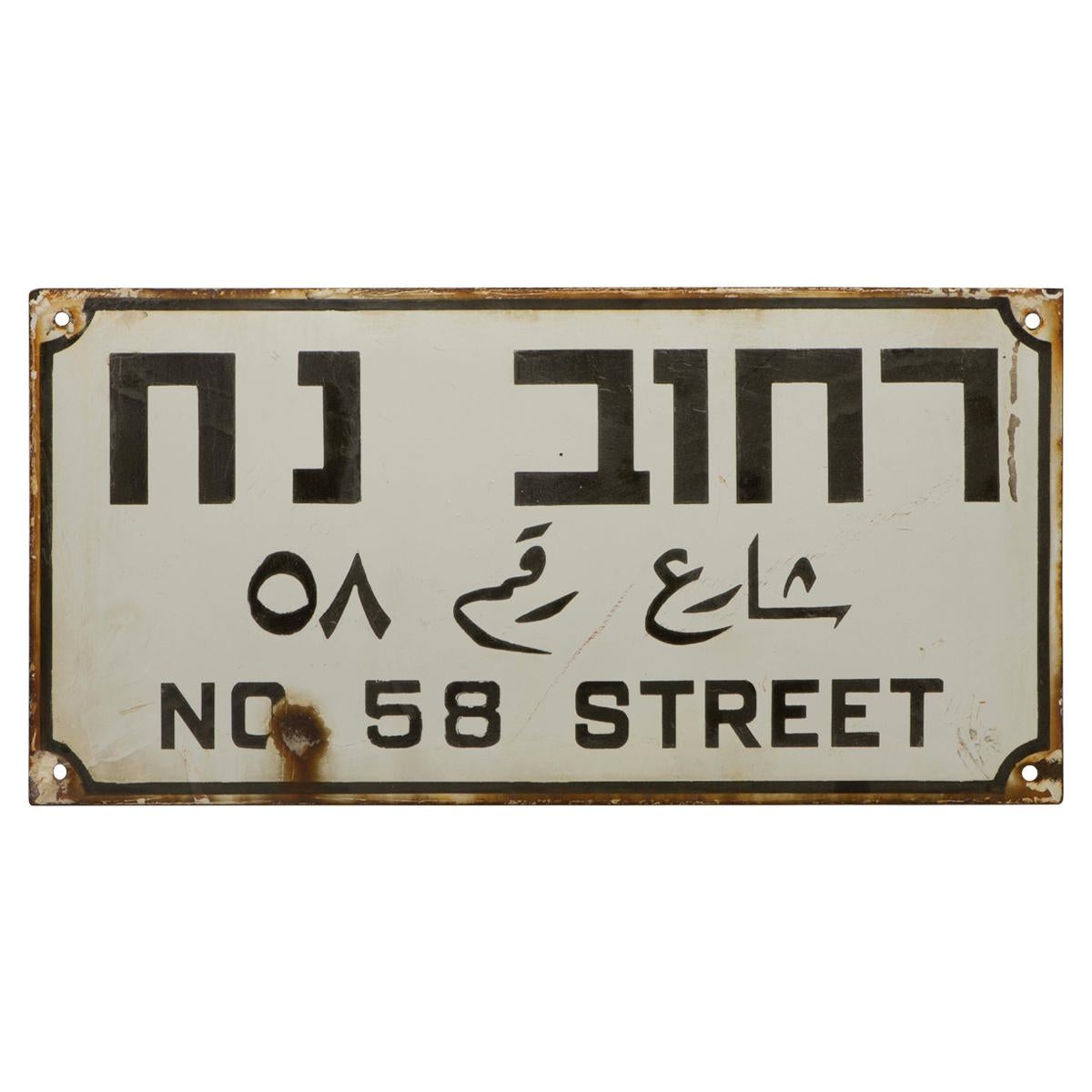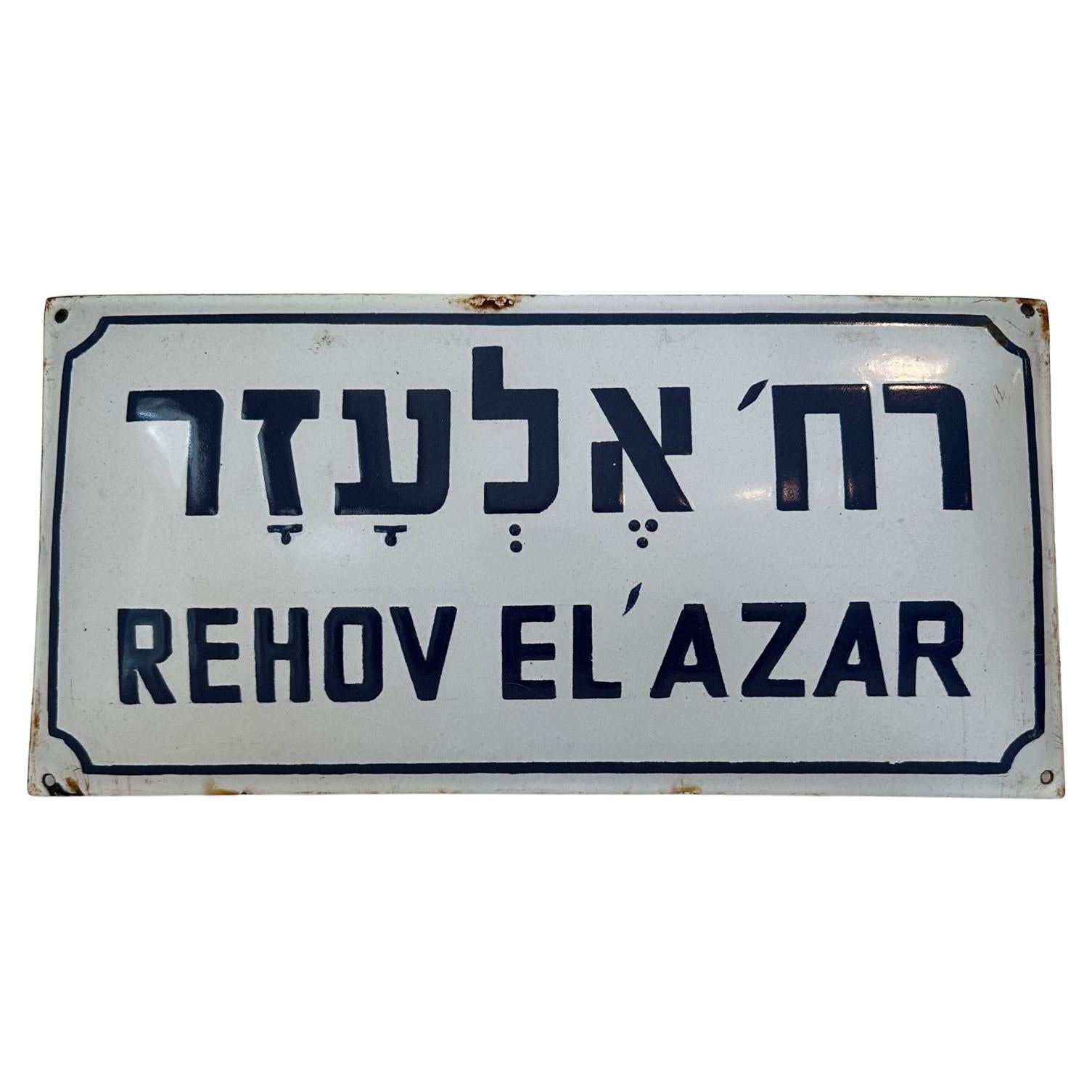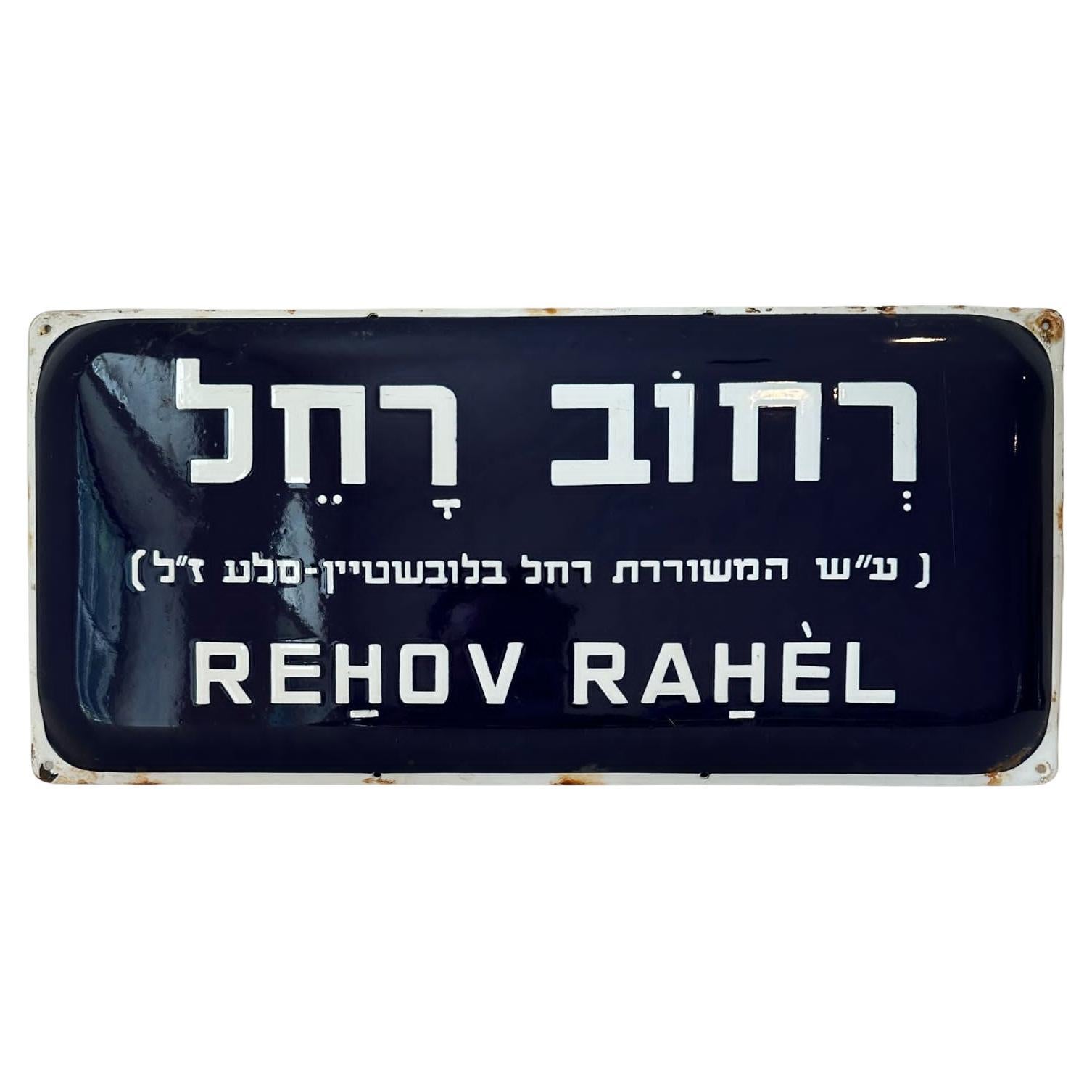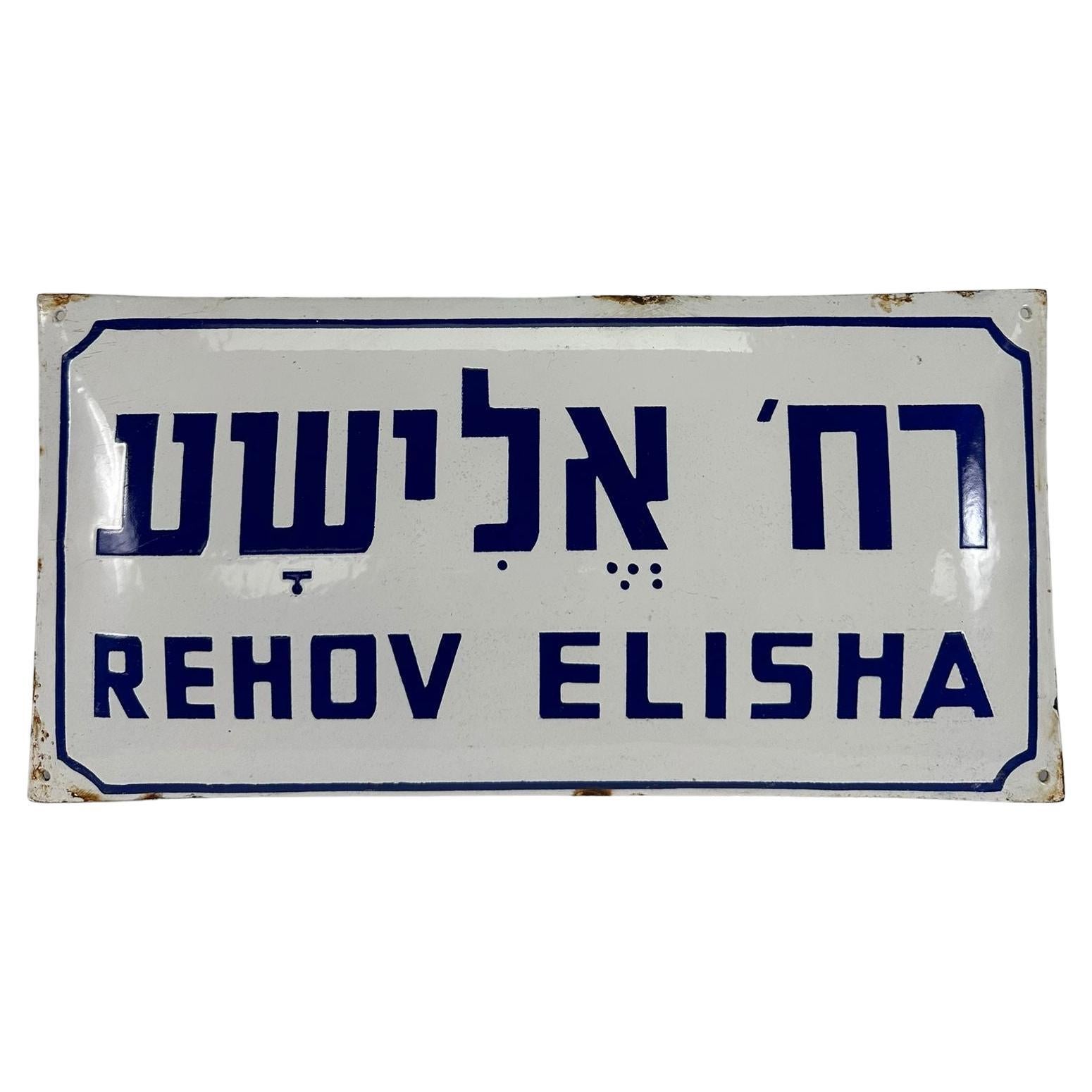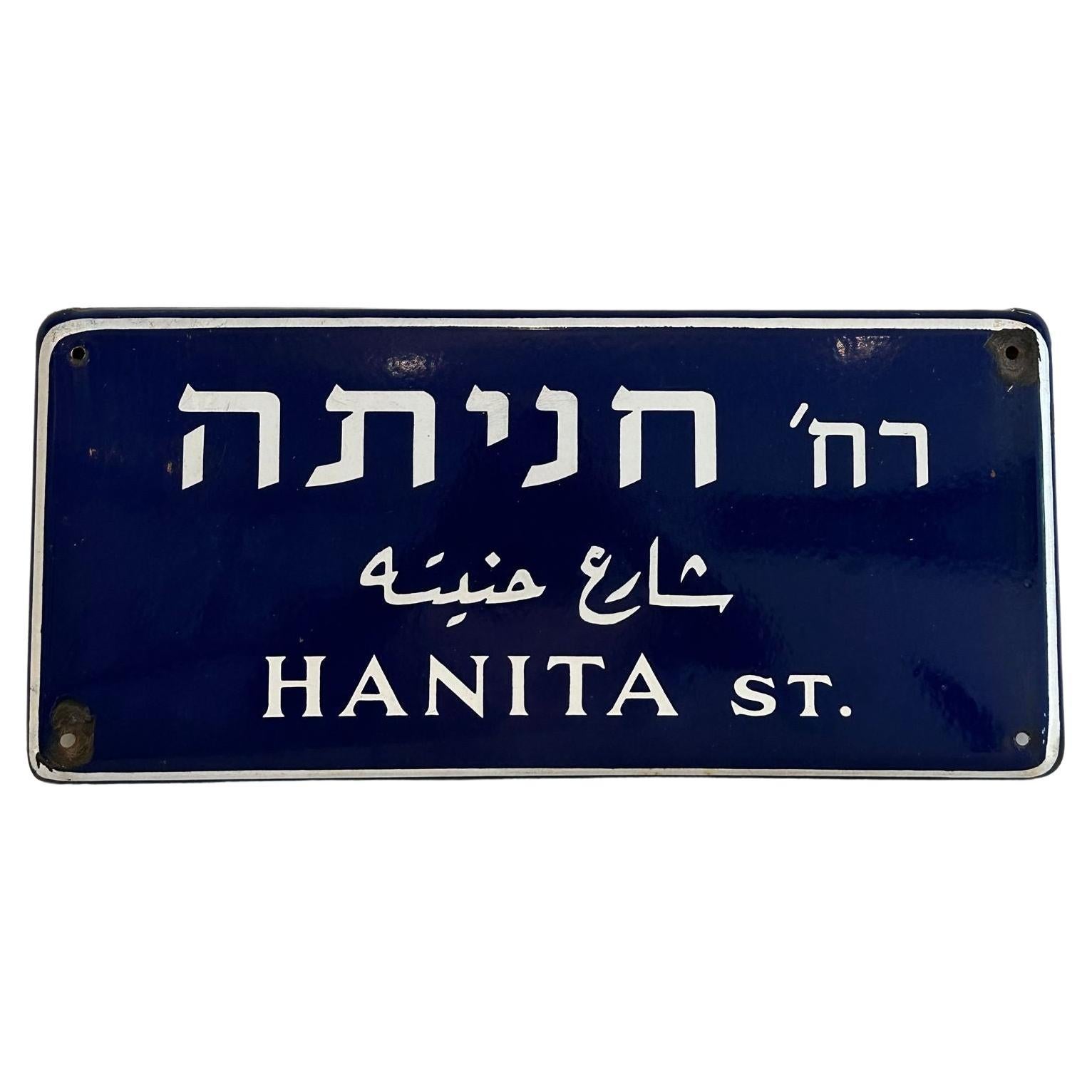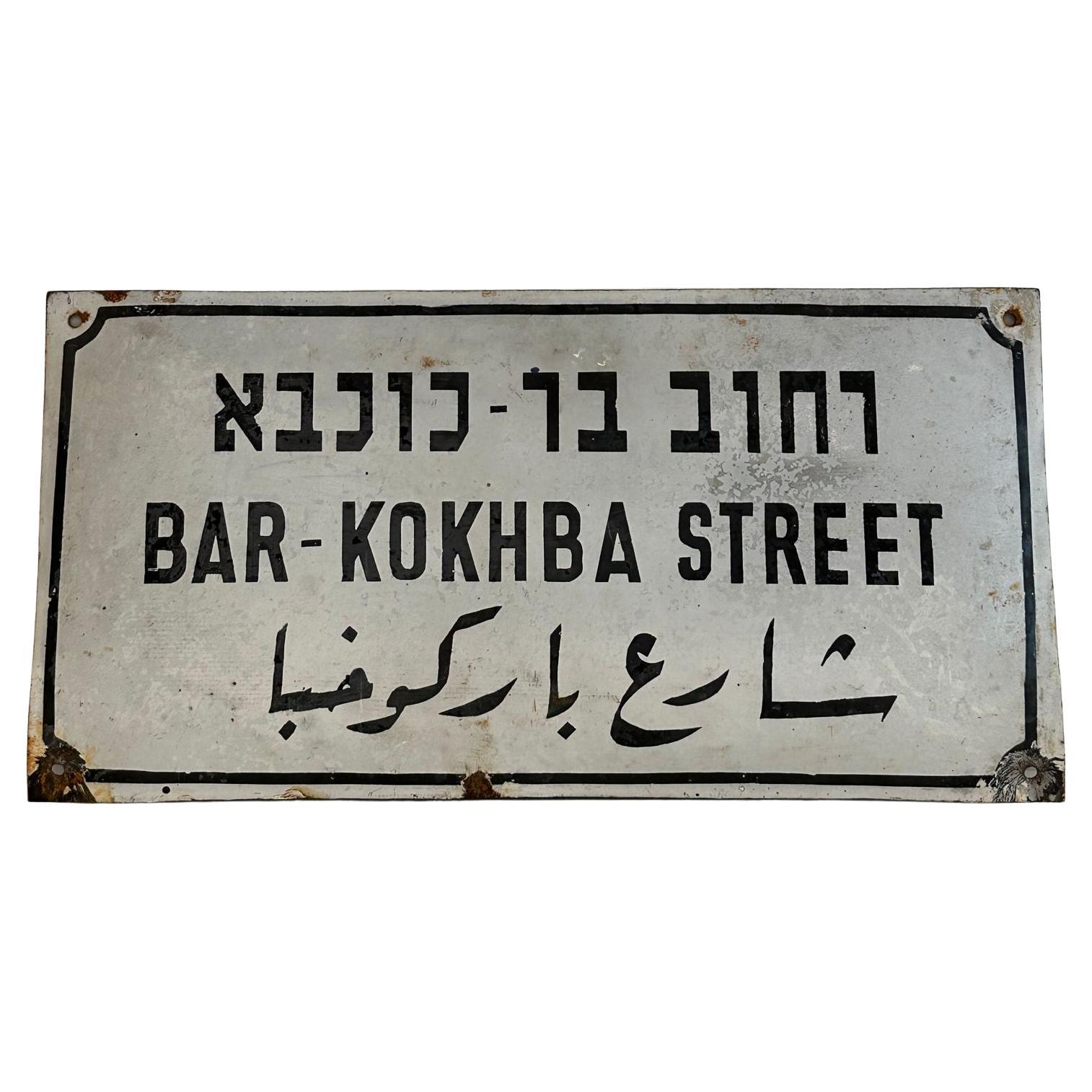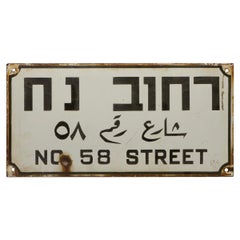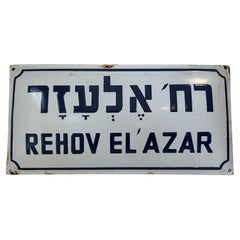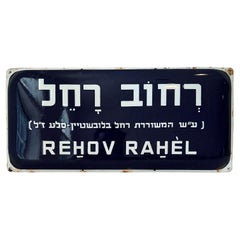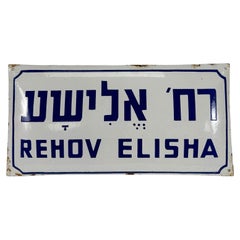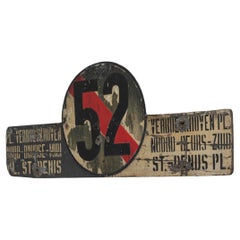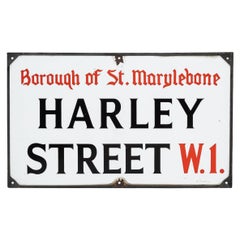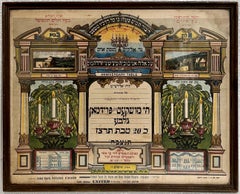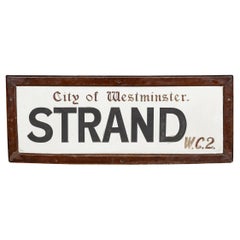Items Similar to Early 20th Century Israeli Iron and Enamel Street Sign
Want more images or videos?
Request additional images or videos from the seller
1 of 6
Early 20th Century Israeli Iron and Enamel Street Sign
$2,571.20
$3,21420% Off
£1,950.97
£2,438.7120% Off
€2,230.76
€2,788.4520% Off
CA$3,591.27
CA$4,489.0920% Off
A$3,993
A$4,991.2520% Off
CHF 2,084.93
CHF 2,606.1620% Off
MX$48,604.57
MX$60,755.7120% Off
NOK 26,602.74
NOK 33,253.4320% Off
SEK 24,925.50
SEK 31,156.8720% Off
DKK 16,648.55
DKK 20,810.6920% Off
Shipping
Retrieving quote...The 1stDibs Promise:
Authenticity Guarantee,
Money-Back Guarantee,
24-Hour Cancellation
About the Item
Three languages iron and enamel street sign, circa 1920.
The sign was made to Honor Bezalel who was the chief artisan of the Tabernacle and was in charge of building the Ark of the Covenant, assisted by Aholiab.
The three languages indicate the sign was made during British mandate in Palestine or in the early days of Israel. The sign is made of iron and enamel - in later years iron signs in Israel replaced with cheaper aluminium signs.
A historical memorabilia from Israel.
Every item in Menorah Galleries is accompanied by a Lifetime "Certificate of Authenticity" and additional documentation and information regarding the individual artifact and its culture.
- Dimensions:Height: 7.88 in (20 cm)Width: 15.75 in (40 cm)Depth: 0.4 in (1 cm)
- Materials and Techniques:
- Period:
- Date of Manufacture:circa 1920
- Condition:Wear consistent with age and use.
- Seller Location:New York, NY
- Reference Number:1stDibs: LU5281220515252
About the Seller
5.0
Recognized Seller
These prestigious sellers are industry leaders and represent the highest echelon for item quality and design.
Established in 2006
1stDibs seller since 2020
130 sales on 1stDibs
Typical response time: 1 to 2 days
- ShippingRetrieving quote...Shipping from: New York, NY
- Return Policy
Authenticity Guarantee
In the unlikely event there’s an issue with an item’s authenticity, contact us within 1 year for a full refund. DetailsMoney-Back Guarantee
If your item is not as described, is damaged in transit, or does not arrive, contact us within 7 days for a full refund. Details24-Hour Cancellation
You have a 24-hour grace period in which to reconsider your purchase, with no questions asked.Vetted Professional Sellers
Our world-class sellers must adhere to strict standards for service and quality, maintaining the integrity of our listings.Price-Match Guarantee
If you find that a seller listed the same item for a lower price elsewhere, we’ll match it.Trusted Global Delivery
Our best-in-class carrier network provides specialized shipping options worldwide, including custom delivery.More From This Seller
View AllEarly 20th Century Israeli Iron and Enamel Street Sign
Located in New York, NY
Three languages iron and enamel street sign, circa 1920.
The sign was made for 58 street in the city of Haifa. The three languages indicate the sig...
Category
Vintage 1920s Decorative Art
Materials
Iron, Enamel
$936 Sale Price
20% Off
Mid-20th Century Enamel and Iron Israeli 'El'azar' Street Name Sign
Located in New York, NY
Mid-20th century handmade Israeli street name sign. Made of enamel and iron, this street sign was created shortly after the establishment of the state of Israel in 1948. The sign is ...
Category
Vintage 1940s Israeli Mid-Century Modern Decorative Art
Materials
Enamel, Iron
$1,440 Sale Price
20% Off
Mid-20th Century Enamel and Iron Israeli 'Rah'el' Street Name Sign
Located in New York, NY
Mid-20th century handmade Israeli street name sign. Made of enamel and iron, this street sign was created shortly after the establishment of the state of Israel in 1948. The sign is written in bolt white letters over a dark blue background, alluding to the colors of the national flag of the newly established state.
The sign names the street 'Ra'hel' (Rachel) in Jerusalem in both Hebrew and English letters (in transliteration).
The origin of the name Rachel comes from the book of Genesis in the Bible, where it appears as the name of a biblical figure - a shepherdess, the wife of Jacob our father, the daughter of Laban the Armenian, the sister of Leah his mother and one of the four mothers of the people of Israel. Rachel was also the mother of Joseph the righteous and Benjamin.
However, this sign refers to the poet Rahel Bluwstein, more famously known as Rachel the Poetess, who is considered the “founding mother...
Category
Vintage 1950s Israeli Mid-Century Modern Decorative Art
Materials
Enamel, Iron
$1,440 Sale Price
20% Off
Rehov Elisha – Israeli Enamel Street Sign (1948)
Located in New York, NY
This enamel-on-iron street sign, made in Israel in 1948, displays the name "Rehov Elisha" in both Hebrew and English. The Hebrew inscription, "רח' אלישע," translates to "Elisha Stree...
Category
Mid-20th Century Israeli Historical Memorabilia
Materials
Enamel, Iron
Mid-20th Century Enamel and Iron Israeli 'Hanita' Street Name Sign
Located in New York, NY
Mid-20th century handmade Israeli street name sign. Made of enamel and iron, this street sign was created shortly after the establishment of the state of Israel in 1948. The sign is written in bolt white letters over a dark blue background, alluding to the colors of the national flag of the newly established state.
The sign names the street 'Hanita' in Israel, in both Hebrew and English letters (in transliteration), as well as in Arabic.
The meaning of the name 'Hanita' is double: it is both an inflection of the name Hannah and also meansm 'her spear'. A spear is an ancient weapon...
Category
Vintage 1950s Israeli Mid-Century Modern Decorative Art
Materials
Enamel, Iron
$1,440 Sale Price
20% Off
Mid-20th Century Enamel and Iron Israeli 'Bar-Kokhba' Street Name Sign
Located in New York, NY
Mid-20th century handmade Israeli street name sign. Made of enamel and iron, this street sign was created shortly after the establishment of the state of Israel in 1948. The sign is written in bolt blue letters over a white background, alluding to the colors of the national flag of the newly established state. The sign names the street 'Bar Kokhba' in Israel in both Hebrew and English letters. (In transliteration), as well as in Arabic.
Simon ben...
Category
Vintage 1940s Israeli Mid-Century Modern Decorative Art
Materials
Enamel, Iron
$1,440 Sale Price
20% Off
You May Also Like
1950s Belgian Transportation Sign
Located in High Point, NC
A vintage Belgian wooden sign made circa 1950. This retired transportation sign used to hang over a Brussels tram stop, printed neatly in French an...
Category
Vintage 1950s Belgian Historical Memorabilia
Materials
Metal
20th Century Enamelled Metal London Street Sign For Harley Street c.1930
Located in Royal Tunbridge Wells, Kent
Antique 20th Century enamelled London street sign, crafted for Harley Street, W1 (Central London). This sign features the classic red and bla...
Category
20th Century British Other Historical Memorabilia
Materials
Metal, Enamel
Rare Palestine Antique Hebrew Judaica Yahrzeit Synagogue Sign Memorial Plaque
Located in Surfside, FL
Circa 1890-1920. This Neoclassical, Judaic, Egyptian revival, Orientalist Mizrach sign, was produced in British Mandate Palestine by the chromolithograph process at the beginning of the 20th century. It pictures vignettes of holy places. with a hand written memorial. It was for the Tzedakah charity fund for the century-old institutions in Jerusalem: The great "Torah Center Etz Chaim"; a Free Kitchen for poor children and orphans; the famous Bikur Cholim Hospital with its dispensaries and clinics and the only Home for Incurable Invalids in Eretz Israel. They also worked with Arthur Szyk and Alfred Salzmann.. The A.L. Monsohn Lithographic Press (Monzon Press, Monson Press, דפוס אבן א"ל מאנזאהן, דפוס מונזון) was established in Jerusalem in 1892 by Abraham-Leib (or Avrom-Leyb) Monsohn II (Jerusalem, c.1871-1930) and his brother Moshe-Mordechai (Meyshe-Mordkhe). Sponsored by members of the Hamburger family, the brothers had been sent to Frankfurt, Germany in 1890 to study lithography. Upon returning to Jerusalem in 1892 with a hand press, they established the A.L. Monsohn Lithographic Press in the Old City of Jerusalem. According to the Information Center for Israeli Art A.L. Monsohn "created complex decorations for documents and oriental calendars that combined the tradition of Jewish art with modern printing techniques such as photographic lithography, raised printing and gilding."
The founders of the Monsohn press produced Jewish-themed color postcards, greeting cards, Jewish National Fund stamps, and maps documenting the evolution of the Jewish settlement in Eretz Israel in the nineteenth-twentieth centuries; religious material such as decorative plaques for synagogues, portraits of Old Yishuv rabbis such as Shmuel Salant, Mizrah posters indicating the direction of prayer for synagogues, memorial posters, and posters for Sukkot booths; color frontispieces for books such as Pentateuch volumes and the early song collections of Abraham Zvi Idelsohn (e.g., Shire Zion, Jerusalem 1908); artistic wedding invitations; and labels, packaging and advertisements for the pioneering entrepreneurs of Eretz Israel. The texts appearing in the Monsohn products were in several languages: Hebrew, Arabic, Yiddish, English, German (e.g., a c1920 trilingual Hebrew-English-Arabic "Malaria Danger" broadside warning the public of mosquitoes spreading malaria). Many of the brilliantly colored postcards and maps can be seen online as can the artistic invitations to his children's weddings which Monsohn published in the Jerusalem Hebrew press.
For years, the Monsohn (later, Monson/Monzon) Press was considered the best and most innovative in the country—pioneering in such techniques as gold-embossing and offset printing, among others. Early items for tourists included collections of Flowers of the Holy Land (c. 1910–1918)—pressed local flowers accompanied by scenes from the Eretz Israel countryside and relevant verses from the Bible, edited by Jsac Chagise (or Itzhak Haggis), an immigrant from Vitebsk, and bound in carved olive wood boards. Shortly after World War I Monsohn (now spelled מונזון) used zincography to produce the prints included in the Hebrew Gannenu educational booklets for young children illustrated by Ze'ev Raban of the Bezalel Academy of Art and Design and printed in Jerusalem by Hayim Refael Hakohen (vol. 1, 1919; vols. 2–3, 1920). In 1934 Monsohn moved into the new, western part of Jerusalem, in a shop with four presses and 30 workers, including Abraham-Leib's sons, David, Yosef, Moshe and Shimon, and his daughter Raytse's husband, Abraham Barmacz. The concern did business with all sectors of the city's population, including Arabs, for whom they printed in Arabic. Among their clients were members of the Ginio, Havilio, and Elite families, and Shemen, Dubek, and other renowned national brands, manufacturing products such as wine, candies, oil, and cigarettes. They also printed movie and travel posters, and government posters, postcards and documents, hotel luggage labels...
Category
Early 20th Century Aesthetic Movement More Art
Materials
Lithograph
Antique 20thC Framed Enamelled Metal London Street Sign For Strand, WC2 c.1917
Located in Royal Tunbridge Wells, Kent
Antique 20th Century framed enamelled London street sign, created for Strand, WC2 (Central London, Westminster). This sign showcases the icon...
Category
20th Century British Other Historical Memorabilia
Materials
Metal, Enamel
20th Century Belgian Metal & Wooden Sign On Stand
Located in High Point, NC
Step back in time with this charming 20th Century Belgian Metal & Wooden Sign on Stand, a vibrant homage to the golden era of advertising. "La Préférée Wie...
Category
20th Century Belgian Historical Memorabilia
Materials
Metal
Vintage European Street Sign
Located in Los Angeles, CA
Great vintage European street sign. Deep blue and white. Newly mounted and framed. People at play in the street. Cool piece of wall art.
Category
Vintage 1970s Italian Signs
Materials
Steel
More Ways To Browse
Antique Iron Sign
Israeli Antique
Antique Furniture Israel
Antique And Artisan Gallery
Enamel Street Signs
Israeli Menorah
Used Tabernacles
Antique Tabernacle
Menorah Gallery
Antique Ark
Masonic Furniture
Declaration Of Independence
Captain Line
Train Memorabilia
Antique Furniture Winchester
British Royal Coat Of Arms
Antique Coffin
Flag Pole
